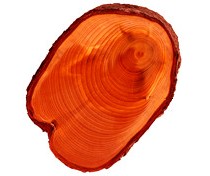DK Nature: Trees
These tall, seed-producing plants have a single woody stem, called a trunk, which supports their great weight. They live for many years and do not die in winter. The largest group of trees is broad-leaved trees.
Trees release oxygen into the atmosphere for other organisms to breathe in. The roots of trees bind soil together, preventing it from being washed away. Trees also provide food and habitats for many animals, and wood for fuel, lumber, and many other products.
Trees grow in two ways. Special cells at the tips of twigs divide, making the twigs grow. Also, a layer of cells under the bark, the cambium, divides, widening the trunk and branches. The new cells that the cambium makes form a visible ring inside the trunk.
Unlike conifers, with their needle-shaped leaves, these trees have wide, flat leaves. Many are DECIDUOUS TREES that lose their leaves in fall, but the broad-leaved trees of a tropical rainforest are evergreen. The mass of leaves of adjacent trees form a CANOPY.
Trees are divided into three groups: broad-leaved trees, palms, and conifers.
| Broad-leaved trees are the largest group, with over 10,000 species. They are dicotyledon flowering plants, and the veins in their leaves branch out like a net. |
| Palm trees, with about 2,800 species, are monocotyledon flowering plants. The veins in their leaves are always parallel. |
| Conifers, with 550 species, have cones instead of flowers. |
Trees that lose their leaves in the fall are called deciduous. They grow in temperate places that have warm summers and cool or cold winters.
When trees shed their leaves, they stop growing. This helps them conserve energy during winter, when there is not enough sunlight to make food. Shedding leaves also helps trees save water, since it stops water from evaporating.
The upper part of the trees in any forest or woodland is called the canopy. It is made up of their branches, twigs, and leaves. Tropical rainforest trees form a dense canopy that is home to many animals.
In hot, steamy rainforests, the tightly packed trees grow rapidly and to great heights. This is because they are all competing for sunlight. The taller the tree, the more light its leaves will receive. Some trees can reach heights of up to 200 ft (60 m).
An epiphyte is a plant that grows on a larger one without harming it. Many epiphytes live high up in the rainforest canopy, firmly anchored by their roots to tree trunks and branches. In the canopy, epiphytes receive much more light than the plants on the forest floor, and more rainwater.
Rainforests are made up of distinct layers. In the emergent layer, the very tallest trees stick out from the canopy. Beneath the canopy is an understory of smaller trees and a shrub layer of big-leaved plants that can live in low-light conditions. Below this is the dark forest floor, where there are fewer, smaller plants.



